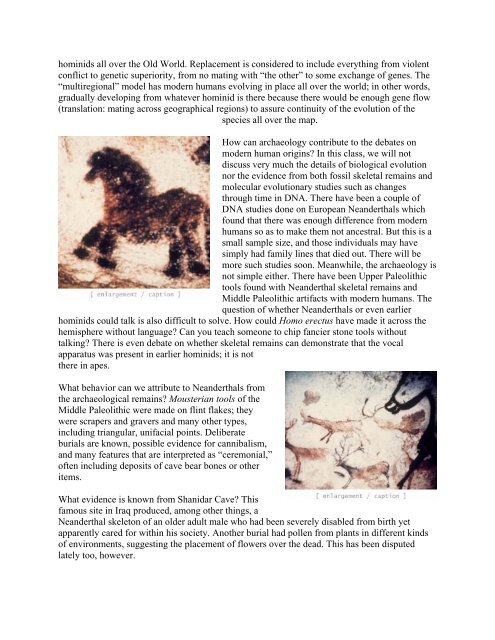INTRODUCTION TO ARCHAEOLOGY Nancy White - Touro Institute
INTRODUCTION TO ARCHAEOLOGY Nancy White - Touro Institute
INTRODUCTION TO ARCHAEOLOGY Nancy White - Touro Institute
You also want an ePaper? Increase the reach of your titles
YUMPU automatically turns print PDFs into web optimized ePapers that Google loves.
hominids all over the Old World. Replacement is considered to include everything from violent<br />
conflict to genetic superiority, from no mating with “the other” to some exchange of genes. The<br />
“multiregional” model has modern humans evolving in place all over the world; in other words,<br />
gradually developing from whatever hominid is there because there would be enough gene flow<br />
(translation: mating across geographical regions) to assure continuity of the evolution of the<br />
species all over the map.<br />
How can archaeology contribute to the debates on<br />
modern human origins? In this class, we will not<br />
discuss very much the details of biological evolution<br />
nor the evidence from both fossil skeletal remains and<br />
molecular evolutionary studies such as changes<br />
through time in DNA. There have been a couple of<br />
DNA studies done on European Neanderthals which<br />
found that there was enough difference from modern<br />
humans so as to make them not ancestral. But this is a<br />
small sample size, and those individuals may have<br />
simply had family lines that died out. There will be<br />
more such studies soon. Meanwhile, the archaeology is<br />
not simple either. There have been Upper Paleolithic<br />
tools found with Neanderthal skeletal remains and<br />
Middle Paleolithic artifacts with modern humans. The<br />
question of whether Neanderthals or even earlier<br />
hominids could talk is also difficult to solve. How could Homo erectus have made it across the<br />
hemisphere without language? Can you teach someone to chip fancier stone tools without<br />
talking? There is even debate on whether skeletal remains can demonstrate that the vocal<br />
apparatus was present in earlier hominids; it is not<br />
there in apes.<br />
What behavior can we attribute to Neanderthals from<br />
the archaeological remains? Mousterian tools of the<br />
Middle Paleolithic were made on flint flakes; they<br />
were scrapers and gravers and many other types,<br />
including triangular, unifacial points. Deliberate<br />
burials are known, possible evidence for cannibalism,<br />
and many features that are interpreted as “ ceremonial,”<br />
often including deposits of cave bear bones or other<br />
items.<br />
What evidence is known from Shanidar Cave? This<br />
famous site in Iraq produced, among other things, a<br />
Neanderthal skeleton of an older adult male who had been severely disabled from birth yet<br />
apparently cared for within his society. Another burial had pollen from plants in different kinds<br />
of environments, suggesting the placement of flowers over the dead. This has been disputed<br />
lately too, however.
















